
The ant–fungus mutualism is a symbiosis seen between certain ant and fungal species, in which ants actively cultivate fungus much like humans farm crops as a food source. There is only evidence of two instances in which this form of agriculture evolved in ants resulting in a dependence on fungi for food. These instances were the attine ants and some ants that are part of the Megalomyrmex genus. In some species, the ants and fungi are dependent on each other for survival. This type of codependency is prevalent among herbivores who rely on plant material for nutrition. The fungus’ ability to convert the plant material into a food source accessible to their host makes them the ideal partner. The leafcutter ant is a well-known example of this symbiosis. Leafcutter ants species can be found in southern South America up to the United States. However, ants are not the only ground-dwelling arthropods which have developed symbioses with fungi. A similar mutualism with fungi is also noted in termites within the subfamily Macrotermitinae which are widely distributed throughout the Old World tropics with the highest diversity in Africa.

Hygrocybe is a genus of agarics in the family Hygrophoraceae. Called waxcaps in English, basidiocarps are often brightly coloured and have dry to waxy caps, white spores, and smooth, ringless stems. In Europe they are characteristic of old, unimproved grasslands which are a declining habitat, making many Hygrocybe species of conservation concern. Four of these waxcap-grassland species, Hygrocybe citrinovirens, H. punicea, H. spadicea, and H. splendidissima, are assessed as globally "vulnerable" on the IUCN Red List of Threatened Species. Elsewhere waxcaps are more typically found in woodlands. Most are ground-dwelling and all are believed to be biotrophs. Around 150 species are recognized worldwide. Fruit bodies of several Hygrocybe species are considered edible and are sometimes offered for sale in local markets.
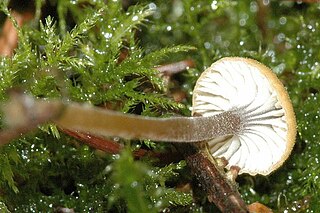
Rickenella is a genus of brightly colored bryophilous agarics in the Hymenochaetales that have an omphalinoid morphology. They inhabit mosses on mossy soils, peats, tree trunks and logs in temperate regions of both the Northern and Southern Hemispheres. Phylogenetically related agarics are in the genera Contumyces, Gyroflexus, Loreleia, Cantharellopsis and Blasiphalia, as well as the stipitate-stereoid genera Muscinupta and Cotylidia. and the clavarioid genus, Alloclavaria.

The Physalacriaceae are a family of fungi in the order Agaricales. Species in the family have a widespread distribution, ranging from the Arctic, (Rhizomarasmius), to the tropics, e.g. Gloiocephala, and from marine sites (Mycaureola) and fresh waters (Gloiocephala) to semiarid forests (Xerula).
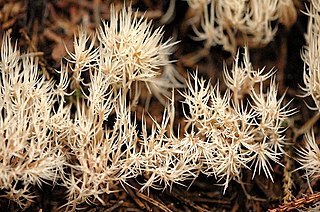
The Pterulaceae are a family of fungi in the order Agaricales. According to a 2008 estimate, the family contained 99 species previously distributed among 12 genera. More recent data from molecular phylogenetic reconstruction showed that members of the genus Parapterulicium are unrelated to Pterulaceae and also polyphyletic. A new genus Baltazaria was created and both genera were moved to Russulales, to families Lachnocladiaceae and Peniophoraceae respectively.

Aphanobasidium is a genus of corticioid or crust fungi in the Radulomycetaceae family. The genus has a widespread distribution and contains several species. This genus was formally considered to be part of the Pterulaceae family.
Parapterulicium is a genus of fungi in the order Russulales. The genus contains two species found in Brazil and Argentina.

Pterula is a genus of fungi in the Pterulaceae family. The genus has a widespread distribution, especially in tropical regions, and contains about 50 species. One such species, Pterula sp. 82168, has yielded potential antifungal antibiotic properties.
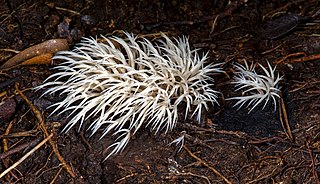
Pterulicium is a genus of fungi in the Pterulaceae family. The genus was previously monotypic, containing the single species Pterulicium xylogenum, found in southeast Asia. However in 2020 a major reclassification of the Pterulaceae family occurred based on phylogenetic analysis and the Pterula genus was split into Pterula, Myrmecopterula, Pterulicium and Phaeopterula by the mycologists Caio A. Leal-Dutra, Bryn Tjader Mason Dentinger and Gareth W. Griffith.
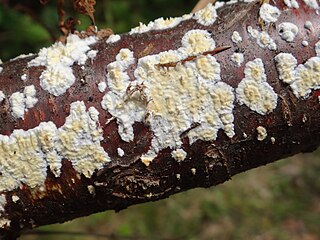
Radulomyces is a genus of crust fungi in the family Radulomycetaceae. The genus has a widespread distribution and contains 11 species. It was circumscribed by Danish botanist Mads Peter Christiansen in 1960, with Radulomyces confluens as the type species. This genus was formally considered to be part of the Pterulaceae family.
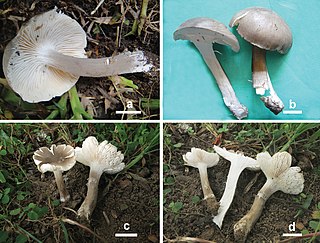
Cantharocybe virosa is a member of the fungal family Hygrophoraceae that has been identified in India, Bangladesh and Thailand. It is an ectomycorrhizal fungus that is toxic for consumption and has no know uses in agriculture, horticulture or medicine. C. virosa is a gray to gray-brown fungus with white to yellowish-white gills that can be found in soil or on mud walls near Cocos nucifera.

Myrmecopterula is a genus of fungi in the family Pterulaceae. Basidiocarps are clavarioid and are associated with ant domestication by members of the genus Apterostigma.

Myrmecopterula moniliformis is a species of fungus in the family Pterulaceae and is the type species of the genus Myrmecopterula. It is associated with fungi cultivating ants of the genus Apterostigma.
Myrmecopterula velohortorum is a species of fungus in the family Pterulaceae. It is associated with fungi cultivating ants of the genus Apterostigma.
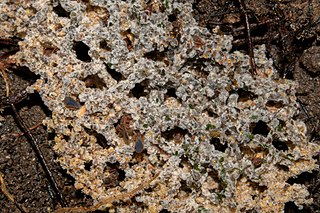
Myrmecopterula nudihortorum is a species of fungus in the family Pterulaceae. It is associated with fungi cultivating ants of the genus Apterostigma.
Phaeopterula is a genus of fungi in the family Pterulaceae. Basidiocarps are clavarioid and resemble species of Pterula.
Radulotubus is a monotypic genus of corticioid or crust fungi in the family Radulomycetaceae containing the single resupinate species Radulotubus resupinatus. This species was found in Yunnan province, China and formally classified in 2016. The specimen was found growing on the fallen trunk of an angiosperm. It was originally placed in the family Pterulaceae and noted to be closesly related with Aphanobasidium and Radulomyces.
Pterulicium caricis-pendulae is a species of mushroom producing fungus in the family Pterulaceae. It has the common name pendulous sedge club.
Pterulicium gracile is a species of mushroom producing fungus in the family Pterulaceae.











